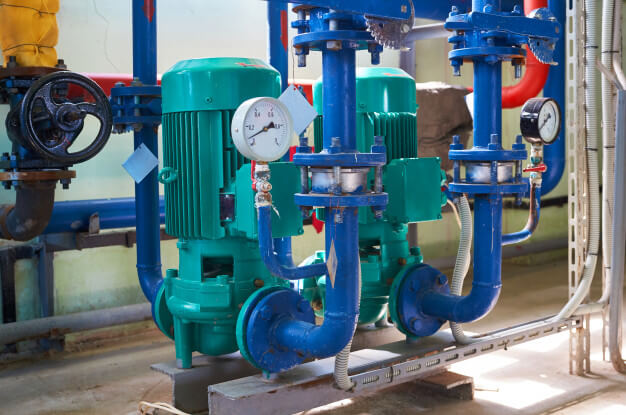Submersible pumps, such as those manufactured by HydroFlo Pumps, are an important component of many industrial applications. This guide from Zone Industries will walk you through the basics you need to know to determine if a submersible pump is right for your application.
What a Submersible Pump Is
Pumps are used to transport liquids from one place to another. All-Flo Pumps submersible pumps differ from other types of pumps because the pump and motor assembly are completely submerged in liquid. Submersible pumps can function while completely submerged because the motor is closely coupled to the pump body and hermetically sealed, forming a water-tight enclosure. Additionally, the enclosure around the motor is usually full of oil. This oil prevents liquid from getting inside the motor and causing a short circuit or other damage.
How a Submersible Pump Works
Because HydroFlo Pumps work by pushing liquid, instead of pulling, they operate very efficiently. The pump uses the head of liquid to do its work without expending any energy to draw fluid into the pump. The pump also saves energy by using the liquid it is submerged in to cool the pump and avoid overheating. The oil and gas industry frequently uses pumps that operate on the Electric Submersible Pumping principle. ESP motors can work under high pressure and temperatures. ESP motors are cost-effective at transporting large volumes of fluids from deep wells but can be expensive to run because of the special electricity cables they require.
Advantages of Submersible Pumps

Crane Pumps submersible pumps are self-priming. Because they run beneath the surface of the liquid being pumped, they do not require priming.
The head pressure of the liquid on the suction end of a submersible pump helps it operate. This makes the pump more efficient and causes it to use less energy, drawing in the fluid than some other types of pumps.
Centrifugal and other positive displacement pumps can be prone to cavitation. Because they are fully submerged, submersible pumps do not have this drawback.
The liquid submersible pumps are submerged in serves as a sound dampener. This makes submersible pumps less noisy than other types of pumps.
Submersible pumps are usually reliable, resist corrosion, and operate efficiently in harsh conditions. They are a good choice for applications that might quickly wear out less durable pumps.
Disadvantages of Submersible Pumps

Anything that is exposed to liquids for long periods will tend to corrode. Additionally, submersible pumps are frequently used to transport abrasive and corrosive liquids. Corrosion can damage the seals and cause leaks and other damage to the motor. Submersible pumps are made from materials that do not corrode easily. These materials cause submersible pumps to be more expensive than other similar pumps.
These pumps need to be inspected frequently so that repairs can be made and the pump’s life can be extended. However, inspections and regular maintenance are made more difficult to perform because many submersible pumps are difficult to access. For this reason, some companies choose to run the pumps until they break and then replace them, rather than maintaining them.
Uses for Submersible Pumps
Because HydroFlo Pumps are compact and inexpensive to install, they are often used in pump and lift stations. This makes these pumps popular choices in the wastewater and grit industry.
Harbors are often dredged with a pump designed specifically to handle liquids with high solid content, called a vertical pump. Seagoing ships also use these pumps for barge unloading and onboard flooding applications.
Grinder and other submersible pumps can be used to convert sewage material to easily handled particles. These pumps are capable of transporting sewage downstream for treatment without obstruction from entry to discharge.
The oil and gas industry often uses ESP submersible pumps to move oil to the surface from oil wells. The vertical turbine pump is frequently used in water wells and boreholes to transport water to the surface.
Choosing the Right Pump for Your Needs
HydroFlo Pumps can be a good choice for many applications that involve moving liquids that are corrosive or abrasive or contain a high level of solids. The team at Zone Industries can help you choose the right pump for your application. Call us at 713-783-8530 or fill out our online form to get more information or request a quote.
Guide to Submersible Pumps | Zone Industries
Submersible pumps, such as those manufactured by HydroFlo Pumps, have various benefits that make them ideal for commercial, residential, and industrial operations. Understanding what these pumps are and how they work is the first step towards choosing the best pump for the job you need. As a leader in the design, installation, and maintenance of pumps, Zone Industries will work with you to find the perfect solution for your needs.
What a Submersible Pump Is
Submersible pumps have airtight sealed motors that have several advantages for certain pumping applications. A high-quality submersible pump, such as Allflo Pumps, should never need to be taken out of the liquid it is submerged in. Because the liquid the pump is submerged in primes the pump, the pumps never need to be manually primed.
Uses for Submersible Pumps

Because HydroFlo Pumps are made to fit in difficult spaces, these pumps can be a good choice for places that are difficult to access or confined. These pumps are also good choices for wells. The ability to place the pump directly in the water source makes it easier to efficiently pump high-quality water into your home, worksite, or business. Additionally, these pumps are useful for draining fields, managing pond filtration, moving sewage and oil wells.
How Submersible Pumps Function
Submersible pumps, such as a vertical turbine pump, function by changing rotary energy into kinetic energy. The pump accomplishes this by using the pressure energy drawn in by the pump. The liquid enters the pump through the intake and is then pushed through the impeller and into the diffuser. After passing through the diffuser, the fluid can flow to the surface, where it can then be used for whatever purpose you need.
The hydraulic motors in these pumps are usually closed-cycle pumps but can also be open-cycle. Whether closed or open, the motors function similarly. These vertically positioned pumps can generate large amounts of pumping power.
Requirements To Use the Pumps
The pump will need to be submerged permanently; otherwise, it could overheat or sustain other damage. However, the issues are usually minor, so while it is a good idea to keep the pump submerged, you do not need to go to extremes to submerge your vertical pump.
Advantages of Submersible Pumps

To get maximum benefits from a submersible pump, it is wise to choose a manufacturer known for high-quality pumps, such as Crane Pumps. Top-quality pumps have numerous advantages:
- These pumps do not use very much energy compared to other similar pumps. Because of this energy efficiency, submersible pumps are a good choice for budget-conscious homeowners and businesses
- Because you do not need to prime these pumps, they are lower maintenance and easier to operate than other types of pumps
- These pumps do not experience cavitation or spikes in pump pressure. Additionally, because they are submerged, the liquid serves as a sound barrier, making these pumps very quiet to operate
- If you have a lot of different jobs to be done, these pumps are a good choice because of their versatility
Disadvantages of Submersible Pumps
We believe that these pumps’ advantages outweigh the disadvantages, but it is still important to be aware of potential drawbacks. There are a few limitations you should consider when choosing a pump:
- While these pumps are useful in many different applications, they are not the best choice for every job. Your Zone Industries representative can help you determine whether a submersible pump is a good fit for the job you need to do
- Because the pumps are constantly exposed to liquids, some of which may be corrosive, the seals can break down, which may lead to damage to the motor
- The liquid surrounding the pump usually keeps the pump cool, but if the liquid dries up, your pump could overheat. You may need to be cautious when using these pumps in wells or other applications where there is a significant danger of the liquid drying up
Work With a Pro
Choosing the right pump for your job will help you avoid costly repair or replacement issues. Whether you choose HydroFlo Pumps or one of the other product lines we carry, the team at Zone Industries has the expertise and experience needed to help you purchase the right equipment for your job. Give us a call at 713-783-8530 or contact us online for information or a quote.
What Is a Submersible Pump and Why Should You Use One? | Zone Industries


